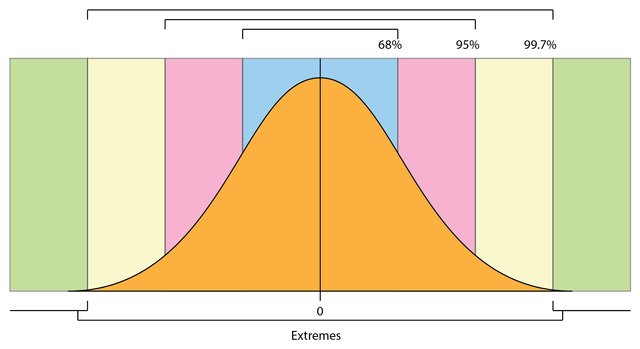Riding the exponential tail

Do you remember much of high school maths?
Do you remember doing anything with standard deviations?
I don't really either.
So, what is it?
A normal distribution curve describes the amount of variation within a set of data values from the mean (average). The further away a point lies from the middle, the more unusual it is in terms of frequency. When I was at school and university, I never really paid much attention in maths or statistics and spent even less time trying to understand how these concepts applied to the real world. I knew they did, but I always thought that it was never going to be my area and had little relevance to what I would end up doing. These days, I still don't know much about maths, but I do see many areas of application and will invest a little time to understand a touch more.
However a few basics are required as a reminder:

If you look at the bell curve above, each section contains a certain amount of the data set within it, with the middle point being the average (0). So, in standard deviation 1 there is about 68% of all occurrences and the further away from 0, the less likely an event will happen.
To imagine this, think of the likelihood of a daily event occurring.
Standard deviation 1: likelihood about twice a week - Perhaps something like watching a movie
Standard deviation 2: likelihood about every three weeks - perhaps something like going out to a restaurant with friends
Standard deviation 3: about once a year - The staff Christmas party
Pretty easy to understand so far. What about standard deviation 4 for the possibility for a daily even to happen?
Standard deviation 4: about once every 43 years (about twice in an average lifetime) Perhaps breaking a bone
Standard deviation 5: about once every 4700 years. (the chance of it happening within our lifetime is less than 2 percent)
Frequency matters
Now, as you realise, this depends on the source of the data set. For the average population, breaking a bone is quite unlikely as the normal person does not open themselves up regularly to high-risk, bone-breaking situations. However, if the set comes from let's say, motocross competitors, where each day their profession exposes them to the opportunity, the likelihood of a particular person experiencing the event increases. So with frequency, the instances of a possible event goes up. applied across an entire population, the average is skewed (pushed one way or another) because of these high-incidence outliers.
Let's innovate
Take this into the workplace and apply it to change ideas. Let's work under the assumption that all ideas are for the better (a big assumption). An idea that lays in the 1st deviation is one that slightly improves upon the current state, it doesn't move far from today's position. The 2nd deviation has a larger affect but nothing significantly ground-breaking, and in the 3rd, an idea is quite different from the current position and has a significant impact on the business. How many ideas do you need to achieve one of each?
If we put a team together tasked with developing innovation within an organisation and they begin throwing ideas around. Still assuming no negative ideas, of course.
1st: 3 ideas produce 2
2nd: 22 ideas produce 1
3rd: 370 ideas produce 1
What about the 4th: only one in almost 16,000 ideas lay here. And what could this idea achieve (still acting under the assumption it is for the better)? Major disruption and organisational impact that may create a complete strategy shift.
And if it is in the 5th?: one in 1.7 million ideas produces an entire industry changer that would have global repercussions and knock on to unrelated industry.
Sounds easy enough to disrupt global industry as all the team needs to do is have 1.7 million ideas. Well, yes and no - as always. For a start, if the team is together for 40 years and works continuously they will need to have 116 ideas per day. Secondly, the hardest part for the team isn't creating any one idea, but selling the idea to decision makers, getting resources and implementing it into the organisation effectively so that it can have a chance to make an impact.
Feeling resistant
Most people understand that implementation of organisational change can be difficult for even the most minor of movements and the more stable (comfortable) the culture or environment, the less likely people want to move. The further away from the average an idea deviates, the more uncomfortable it is for those required to enact it. Essentially, more resistance is met. If we then plot the normal distribution of 100 people's willingness to change from one work process to another. With 0 being unwillingness. 68 people are slightly open to change, 27 are somewhat open to change, 4 are very open and 1 (actually 1/3 of a person) is exceptionally open to change.
The chart below represents that the further the thought deviation from the mean, the greater the resistance to change (willingness to accept an alternative position)

Get thinking
Going back to our team though, they need not work alone on their ideas. Their ideas are being driven and directed by experience and affected by external ideas that are invading their thoughts. Plus, as their ideas are introduced to the organisation, they meet with varied minds and as more heads take the responsibility to think deeper, the more new ideas get formed. As people add their own adjustments and flavours, these unintentional collaborations inadvertently lower resistance, as more people feel part ownership rights to the developing ideas. The more these ideas meet, collide and interact, the stronger they develop and the closer we come to not only discovering world-changing ideas but the more likely it is that any given idea will fall upon the ears of those with the resources, influence, skills or intelligence to realise its full potential. And the more this process happens, the more tolerant we become for future change cycles. Small changes, introduced a bit at a time, really can change the world as they lead on to the large.
Getting change requires supporting change
Each day we hear how movement is necessary, how innovation and growth must take place, how companies, organisations and governments must develop in order to be efficient, effective and relevant in an ever changing world. Leaders are tasked with developing and attempting to implement ideas into organisations where 2/3rds of the people have quite strong resistance to the prospect of moving from the status quo. Even an average-impact idea that lies in the 2nd deviation has little chance of gaining momentum in most environments let alone an extreme outlying thought that could change a company, country or start a global movement. (Side note: This may indicate towards a critical flaw in majority rule if the majority wish to remain comfortable and standing still)
What I am attempting to demonstrate is that as diversity of thinking increases so does resistance to it. But, if people train to widen their tolerances, think deeply, talk openly, question and push thoughts both together and apart, we can develop and support some amazing movements. We could turn the representation of extremist thinking from a media negative into one of global advantage that aims to bring maximum benefits to all by creating new normals where acceptance, resilience, creativity, passion, forgiveness, responsibility, compassion and trust become the average.
Looking backwards, moving forwards
Those that live beyond the 3rd deviation need to be nurtured not starved. Supported, not ostracised. Seneca, Plato, Da Vinci, Galileo, Curie, Einstein, Gandhi, Turing, Mother Theresa, Hawking Von Neumann and many, many more are extremists of the mind. They pushed the boundaries of their thinking into areas far from the average thoughts of their times and added enormous value to our world for doing so. Going forward, economic stability, social prejudices, world hunger, disease, environmental issues and war won't be solved by thinking like yesterday, they will be cured by outliers and freaks of thought that get supported by the other 99.7 percent.
Taraz
Note: Remember that this is a piece of prose more than a maths lesson. There are many factors that have been omitted that could come into play that would influence idea creation and how far from the average they could be. And my normal disclaimer for such things: Maths at any level past counting oranges and apples isn't my area so, if there is anything you can shed light on let me know.